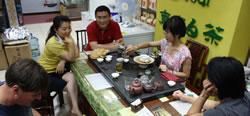Chinese tea fermentation in an image
The level of fermentation is THE element used to categorise teas. For example, green teas are unfermented, Oolong teas are semi-fermented and black teas are fully fermented. The level of fermentation of teas is high associated with its appearance and taste: Green teas are light in colour, more ‘grassy green’ and refreshing in aroma and taste; Black teas are more smooth in texture and often dark yellow and red in tea brew colour.
 A way of illustrating this is through Oolong tea, classified as semi-fermented. Different Oolong teas have various fermentation levels, which is carefully controlled and crucial to the nature of the final product. During Oolong tea’s processing, one of the important steps is to ‘bruise’ the edges of the tea leaves by putting the leaves in a bamboo cylinder and toss around (Yao Qing - 摇青). This process triggers the enzymes to be released from the cells and start a chain of chemical reactions within the tea leaves to facilitate the later fermentation. Once the tea leaves are fermented to the desired level, a process called Chao Qing (炒青) is applied, where the tea leaves are heated (NOT dired!), often in a wok, with highly skilful temperature control to stop the fermentation to progress further.
A way of illustrating this is through Oolong tea, classified as semi-fermented. Different Oolong teas have various fermentation levels, which is carefully controlled and crucial to the nature of the final product. During Oolong tea’s processing, one of the important steps is to ‘bruise’ the edges of the tea leaves by putting the leaves in a bamboo cylinder and toss around (Yao Qing - 摇青). This process triggers the enzymes to be released from the cells and start a chain of chemical reactions within the tea leaves to facilitate the later fermentation. Once the tea leaves are fermented to the desired level, a process called Chao Qing (炒青) is applied, where the tea leaves are heated (NOT dired!), often in a wok, with highly skilful temperature control to stop the fermentation to progress further.
 The image below is from a semi-fermented Oolong (Zhang Ping Shui Xian). As seen on image, the edges of the tea leaves are red in comparison to the rest of the green ( called ‘green leaf of golden edge’ - 金边绿叶 in Chinese). The red part is where the leaves are fermented and border between the red and the green is where the fermentation stopped.
The image below is from a semi-fermented Oolong (Zhang Ping Shui Xian). As seen on image, the edges of the tea leaves are red in comparison to the rest of the green ( called ‘green leaf of golden edge’ - 金边绿叶 in Chinese). The red part is where the leaves are fermented and border between the red and the green is where the fermentation stopped.
All teas are categorised around their levels of fermentChinese Oolong teaation, and maybe some additional elements if relevant.


 Tie Guan Yin is lightly fermented in comparison to the other Oolong teas, which is what gives it the deep green appearance. Its tastes is also gravitated towards the green tea end of the spectrum, refreshing and fragrant, yet with Oolong teas’ full body flavour and smooth texture. Some describe its fragrance as similar to a mild version of jasmine, but not as strong and over powering and of course it is not scented.
Tie Guan Yin is lightly fermented in comparison to the other Oolong teas, which is what gives it the deep green appearance. Its tastes is also gravitated towards the green tea end of the spectrum, refreshing and fragrant, yet with Oolong teas’ full body flavour and smooth texture. Some describe its fragrance as similar to a mild version of jasmine, but not as strong and over powering and of course it is not scented. 
